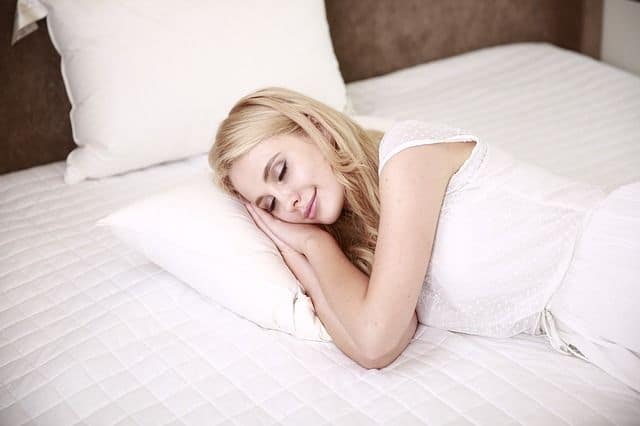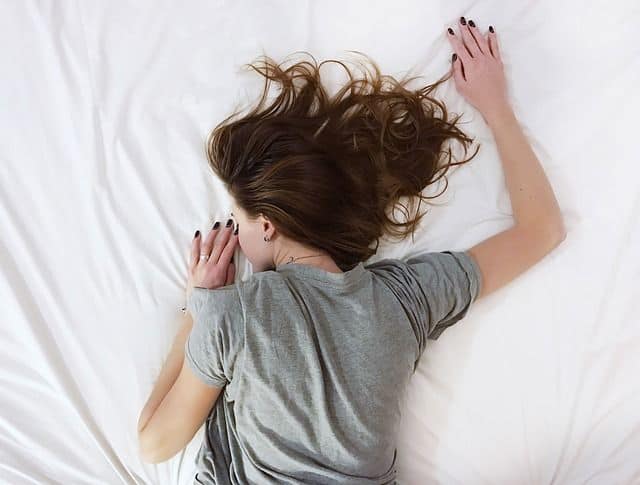Many people like sleeping on their sides. It’s a comfortable position and allows you to curl up into a ball for extra warmth and comfort. But is it a good position when you’re sleeping on a memory foam mattress?
So, is memory foam good for side sleepers? Yes, memory foam is good for side sleepers. It keeps your weight evenly distributed and ensures you maintain good posture throughout the night.
To learn more about how memory foam mattresses can affect your sleep, read on.

Main Benefits of Using Memory Foam Mattress for Side Sleepers
There are two main benefits side sleepers can get by using memory foam pillows and mattresses.
They can contour to the body
Like we’ve mentioned, memory foam can contour to the user’s anatomy.
That doesn’t necessarily mean that it can contour to your bones or your figure alone, though. It can actually contour to your entire body, which means that whenever you switch your sleeping positions you’ll find yourself in a comfortable spot.
Additionally, a lot of the pressure gets relieved as you start to drift in the mat gently. While thicker mattresses tend to preserve their shape despite the circumstances, memory foam mats adapt to the newly-developing conditions.

Superior support for uneasy sleepers
As there are different types of sleeping positions, there are also two types of sleeping ‘situations.’
First, we have people who don’t move an inch and often wake up in the same spot and position as they were in when they fell asleep.
We have the opposite category: uneasy sleepers who tend to move and roll about the bed.
Uneasy side sleepers tend to rotate from one side to the other dozens of times throughout the night. These pelvic rotations can bring about plenty of pain in the lower back, which further puts a lot of stress on the neck area.
However, a decent memory foam mattress helps to evenly distribute this stress across all the areas on the body. Since most sleepers tend to shift positions when they start feeling uncomfortable, this might even lead to a situation where people stop feeling so uneasy. After you start using a memory foam mattress, you’ll often find yourself sleeping a bit more soundly and prancing around the bed substantially less.
Which Sleeping Position is Best for Memory Foam?
A memory foam mattress provides different kinds of benefits, depending on which side you are sleeping on.
Back sleepers

People who prefer sleeping on their backs can test out a mattress a bit quicker than anyone else. Back sleepers feel out the mattress with their spine, so if a particular model is too thick (or too plushy), most people wouldn’t be able to take a 10-minute nap.
Memory foam mattresses are perfect for back sleepers because they provide excellent lumbar support and give the spine plenty of stability.
Additionally, since the mattress can contour to the person’s anatomy, these can even have therapeutic effects. People who suffer from occasional back pain during sleep may find that memory foam mattresses are beneficial. However, a change in mattress is typically not typically capable of curing chronic pains. If you suffer from constant pain during or after sleep, you should contact your doctor.
Front sleepers

On the opposite end of the spectrum are the front sleepers – people who like to dive headfirst into their pillows. This manner of sleeping puts the most stress on your body since your back – which is supposed to support you as you sleep – does not even touch the mattress at all.
Front sleepers usually hate thicker mattresses and avoid spring-mat models altogether, but most of them love memory foam mattresses for one simple reason – the contouring capabilities of a memory mat alleviates the bulk of the pressure put on the shoulders and hips.
If you’re a front sleeper, a memory foam mat will support and align your spine in the most natural way possible, which substantially reduces the pressure put on the lower back.
Side sleepers

Side sleepers put a lot of bodyweight on their shoulders, and a portion of it goes onto the hips as well. Regardless of how comfortable the mattress you’re sleeping on is, there is a big possibility that your spine is going out of alignment if you’re not using a memory foam mattress while sleeping on your side.
The reason for this is simple: as you sleep, your body is unconsciously searching for the most comfortable position. This does not necessarily mean the healthiest position, though.
A memory foam mattress helps with even distribution of your body’s weight, supporting the waist and keeping the spine in a perfectly healthy alignment. It’s also important that you have a high-quality pillow to keep your neck in alignment with the rest of your spine. If you don’t, you can experience neck pain even if you invested in a great memory foam mattress.
What is a Memory Foam Mattress?

Visco-Elastic foam is a material popularly called ‘memory foam,’ and it was designed by NASA during the ’60s to combat high-pressure levels that astronauts struggled with as they left (and came back to) the atmosphere.
It wasn’t until long that bed makers found uses for memory foam and started implementing it in their designs. They were intrigued by memory foam’s ability to contour to the human body and thought it might be a good substance for sleeping. It turns out they were right.
While many people think of a memory foam mattress as pure 100% memory foam, this usually isn’t the case. Most memory foam mattresses aren’t made out of pure memory foam, but a combination of memory foam and several other materials.
All mattresses feature several layers composed of different materials. In most cases, these layers aren’t fragmented equally. Some memory foam mattresses feature only 33% of memory foam material, while others have over 90%.
So, in a nutshell, a memory foam mattress is a type of mattress that features a material called Visco-Elastic foam that was specifically designed to contour to the user’s anatomy. This not only makes it perfect for side sleepers; it makes it ideal for every type of sleeper.
Layers of a Mattress
Understanding what goes on inside a memory foam mattress will give us a better understanding of why it’s so good for side sleepers.
Basically, there are a couple of layers of each mattress:
- Ticking: The ticking is usually comprised of woven fabric; in most cases it’s made of linen or cotton. It’s used to blanket the mattress.
- Quilting: This is the first (top) layer, which provides initial cushioning. The main purpose of quilting is to provide additional softness to the top layer. Additionally, it provides breathability and sometimes functions as an insulator (unless insulation pads are added to the equation)
- The middle padding: Just beneath the quilting is the middle padding. The middle layer is where memory foam is usually placed. Some mattresses feature a middle layer with cotton reinforcements that provide even firmer support to certain areas (for instance, lumbar and hip support).
- Insulation pads: The insulation pad layer sits right atop the coils and serves to protect you from actually feeling uncomfortable from feeling the springs (as well as preventing them from actually damaging the mat).
- Extra support laye: Mattresses that are designed with a more substantial capacity workload have an extra support layer for added durability.
Certain manufacturers of memory foam mattresses might put them in other layers as well, but you’ll typically find it in the middle layer.
Final Thoughts
It’s safe to say that memory foam is excellent for any sleeper, side-sleepers in particular.
SleepingReport.com copyright article was updated on ..
Memory foam mattresses are genuinely comfortable and can even be therapeutic in a sense as they help correct spine alignment, alleviate back pain, and ultimately improve the quality of your sleep.

